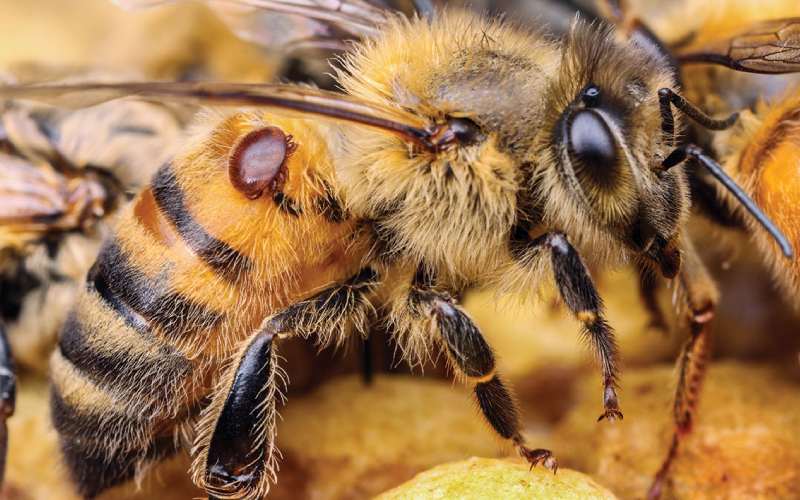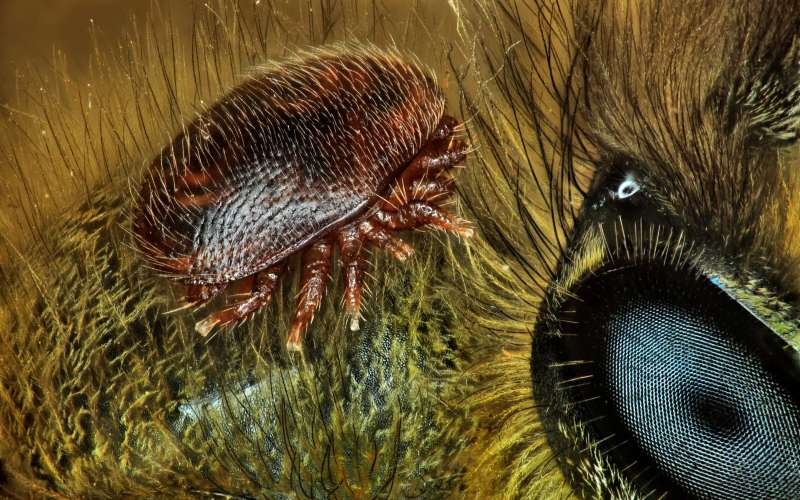
As majority of Kenyans take up bee farming, it is important to realise that this venture too may be affected by pests and diseases that attack the bees and the honey leaving behind a trail of destruction.
One of the major pests of the honey bee is a mite called Varroa destructor.
What is Varroa destructor
Varroa destructor is responsible of Varroatosis (or Varroosis), an external parasitic disease that attacks honeybee colonies (adult bees and especially the brood). It causes the major economic losses to the beekeeping sector because it is widespread and it has a strong adaptability to the treatments.
This mite affects both the brood and the adult bees. It weakens the adult bees by sucking their hemolymph. The weakened bees are more susceptible to other diseases, especially viral pathologies. The first to suffer are the stronger colonies with more brood because of the higher possibility of the mite to replicate at the brood level.
How does the mite look like?
Varroa destructor has a remarkably different morphology between the two sexes. Only Varroa females cause the depriving parasitic action on bees. The adult female is reddish-brown with elliptical shape. It has four pairs of legs that enable the mite to move very quickly inside the hive. The male has only a reproductive role and features a spherical body shape and whitish colour. It is smaller than the female.
The parasite at all developmental stages feeds of the adult honeybee for sustenance, leaving open wounds on the bees. The compromised adult bees are more prone to infections. Varroa can live up to five days out of the hive if the environment is favourable for its survival (temperature, humidity). The life of the Varroa female varies on average from two months to up to five months.
What are the symptoms of mite infestation?
In bees’ colonies contaminated by Varroa it is possible to observe: the parasites on the body of adult bees, scattered brood (index of high mortality of larvae), a typical stench of dead brood, smaller bees, bees with deformed wings, clusters of bees restless and unable to fly, weakening of the colony as it becomes less populated and due to the reduced capacity of the bees in the collection and storage of supplies, abnormal swarming (especially at the end of the season) and replacement of the queen.

The average lifespan of adult bees in heavily parasitized colonies decreases ranging from 25 to 50 percent. Varroa not only sucks the larvae and adult bees, it also causes little wounds on the body of the bees and makes them more vulnerable to other pathogens such as viruses, fungi and bacteria. This effect is augmented also by the possibility of viral multiplication in the salivary glands of Varroa.
How are the mites transmitted?
This parasitic disease is transmitted very easily by direct contact from infested to healthy bees such as during the visit of a flower, by drones who can freely enter different hives, during robbing of infested hives, as effect of drifting of infested worker bees among adjacent hives. But the transmission may also occur by the direct action of the beekeeper for example by transferring parasitized brood combs from one colony to another or by the migratory beekeeping practice.
How to monitor?
Since the evolution of the disease is not very evident, the monitoring of the number of parasites in each hive through periodic inspections is very important. The diagnosis of infestation can be carried out by: checking the number of parasites that fall on the hive bottom; checking the number of Varroa mites affecting the male brood (which is the most affected); checking if the parasites are visible to the naked eye on adult bees, meaning that there are high levels of infestation; applying the World Organization for Animal Health (OIE)-endorsed method by which adult bees are dipped in alcohol and stirred in order to separate the Varroa mites from the bees; applying the powder sugar empirical method, which entails sprinkling powder sugar on bees collected in a jar and shaking it to cause the Varroa to fall through a mesh as this allows to count the mites easily.
Want to get latest farming tips and videos?
Join Us
 The Standard Group Plc is a multi-media organization
with investments in media platforms spanning newspaper print operations,
television, radio broadcasting, digital and online services. The Standard Group
is recognized as a leading multi-media house in Kenya with a key influence in
matters of national and international interest.
The Standard Group Plc is a multi-media organization
with investments in media platforms spanning newspaper print operations,
television, radio broadcasting, digital and online services. The Standard Group
is recognized as a leading multi-media house in Kenya with a key influence in
matters of national and international interest.
 The Standard Group Plc is a multi-media organization
with investments in media platforms spanning newspaper print operations,
television, radio broadcasting, digital and online services. The Standard Group
is recognized as a leading multi-media house in Kenya with a key influence in
matters of national and international interest.
The Standard Group Plc is a multi-media organization
with investments in media platforms spanning newspaper print operations,
television, radio broadcasting, digital and online services. The Standard Group
is recognized as a leading multi-media house in Kenya with a key influence in
matters of national and international interest.








